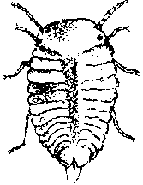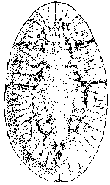|
|
Back to Pest Identification and Diagnosis
| Introduction to Scales | Boisduval Scale | Fern Scale | ||
| Hemispherical Scale | Brown Soft Scale | Tessellated Scale |
 |
 |
 |

|
|||
| Females and Young Scales From: University of Maryland |
Females and Young Scales From: Texas Citrus |
Crawler From: NC Extension |
Mature Female From: NC Extension |
| DESCRIPTION | |
|
Adults: Living adult female brown soft scales are pale yellowish green to yellowish brown, often mottled with brown spots. Older females are brown. The body is usually oval in outline, 2.5 to 4 millimeters in length and slightly convex in profile. The shape tends to vary according to position on the host plant. Males look like tiny two-winged wasps or flies and are rare.
Other Stages: Crawlers and young nymphs are yellow and almost flat in profile. Parasitized nymphs are dark brown to black and convex. Crawlers have well-developed legs and antennae and are quite active until settling. Older nymphs are sessile. |
|
| BIOLOGY | |
|
Host Plants: Brown soft scale has been reported feeding on hundreds of different plants. It can survive on most greenhouse plants, but seems to prefer perennials over annuals. Ferns are a favored host.
Damage: Brown soft scale is probably the most frequently encountered scale on plants indoors. Infestations of brown soft scale can become so heavy as to encrust the stems and petioles of their host plant. They also settle on leaves, usually along midribs and occasionally on the fruit. Large colonies remove large quantities of plant fluids and can cause wilting, but they seldom kill their host. Immatures and adults produce much honey dew that serves as a medium for the growth of sooty molds. These fungi inhibit photosynthesis and make infested plants unsightly. Other insects such as ants and wasps are attracted to feed on the honeydew. Life Cycle: Females are ovoviviparous and retain the eggs in the body until hatching. Brown soft scales are born as active crawlers but remain under the body of the female for a short time before emerging and selecting a feeding site to settle and complete their development. Females molt twice before reaching maturity. Males undergo four molts before emerging as winged adults, but are rarely seen. All stages are found throughout the year in warmer regions and in greenhouses. Brown soft scales can complete three to seven generations per year depending on temperature. It takes about 60 days to complete a generation. |
|
| MANAGEMENT STRATEGIES | |
|
Brown soft scales are surprisingly difficult to control even though there is an external egg stage and only a few very young nymphs are protected by the body of the mother.
Biological Control: Although reported as a pest species of many host plants in many countries, outdoors it may be suppressed by natural enemies in many areas. Scutellista cyanea Motschulsky is a common parasite and Metaphycus luteolus Timberlake controls brown soft scale in California. The lady beetle Ryzobius lophanthae is a soft scale predator. Pesticides: For specific chemical control recommendations, consult the Cooperative Extension Service. |
| Introduction to Scales | Boisduval Scale | Fern Scale | ||
| Hemispherical Scale | Brown Soft Scale | Tessellated Scale |
Back to Pest Identification and Diagnosis
 |
(C) Regents of the University of
Minnesota. All rights reserved. |
 |
 |